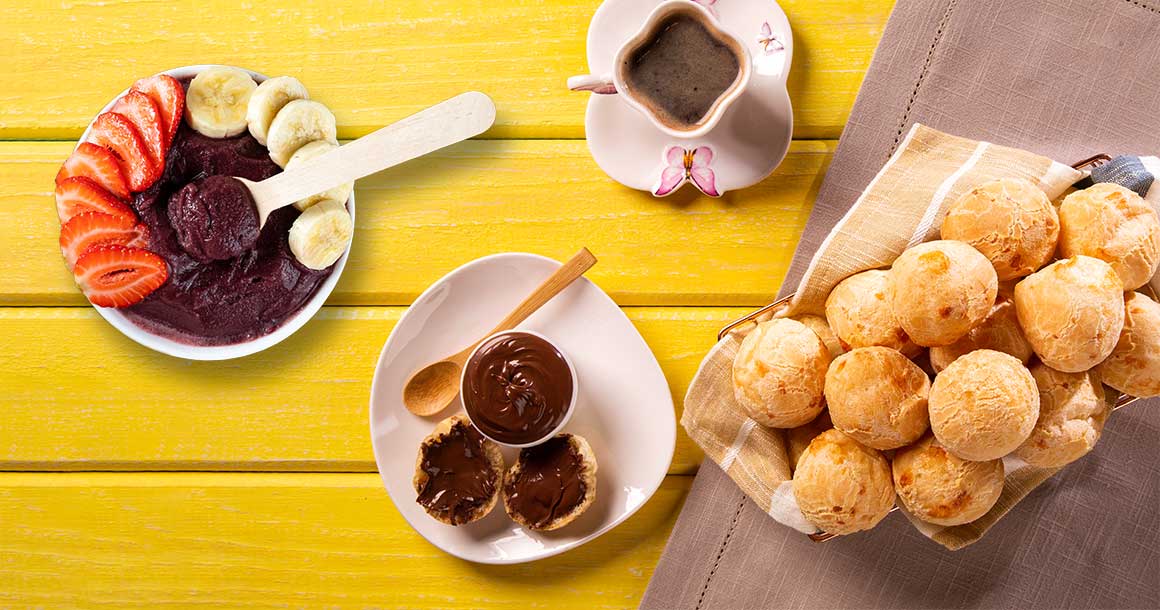
5 Brazilian foods that you can find in Texas
When you think about Brazil, what’s the first thing that comes to mind? Around the world, Brazil is mainly known as the country of soccer and samba and is famous for its amazing beaches, stunning landscapes, and profuse fauna and flora. If you’re a fan of sports, you’ll also remember that Brazil is the birthplace of modern Jiu Jitsu. Additionally, it’s renowned for its diverse cuisine, with delectable Brazilian foods, and being the home of the Amazon Rainforest, the origin of acai
Brazil is all of those things… and more. Like America, Brazil is a continental size country that produces and embraces hundreds of different cultures. If you visit Brazil (and you definitely should visit), you’ll discover that – depending on the Brazilian province you’re in – you’ll experience an almost entirely different country.
And of course: those singular features are reflected in Brazilian cookery, with thousands of unique dishes and delicacies for you to taste. The good news is you don’t have to travel further south to discover those delicious foods. You can find them right here in Texas!
Are Brazilian foods healthy?
Before we proceed to list some of the traditional Brazilian dishes and snacks that you can find in Texas, it’s worth addressing this very important question: Is Brazilian food healthy?
While modern Brazilian cookery is the result of infinite combinations between the native’s traditional food and the recipes brought there by immigrants and settlers from all over the world, a large portion of Brazilian diet is based on local (and usually more natural) ingredients, like roots and vegetables, beans and fruits.
It’s possible that that’s changing over there, with the growing expansion of ultra processed food in Brazilian’s daily meals. But… traditional food is hardly forgotten and most of the Brazilian diet (here and over there) is still based on ingredients with lower doses of sugar and gluten, rich in nutrients and high-quality fats.
So, with that answered… Let’s proceed to the main dish!
1. Brazilian barbecue
It’s fair to say that Brazil and Argentina compete shoulder-to-shoulder for the podium of the barbecue world championship. While each of those countries deals with barbecuing in their particular ways, they both have in common the quality of their meat and the humongous sizes and quantity of the meals.
In Brazil, the meat is usually seasoned exclusively with coarse salt and grilled over burning charcoal. If you’re invited for a Brazilian home barbecue, you’re likely to find premium meat cuts (like picanha) served side by side with sausages, coalho cheese, chicken drumsticks and hearth and, of course… farofa and vinagrete.
Here in Texas, you’ll find Brazilian barbecue at some churrascarias (kind of the Brazilian version of a stake-house), with countless kinds of meat cuts, sliced directly onto your plate. And that’s a whole different experience.
2. Coxinha
Probably the most well-known and popular delicacy in Brazil, coxinha is present in almost every Brazilian cafeteria and family party. Originally, the Brazilian version of coxinha was served as a single (and large) chicken drumstick, bone and everything, wrapped with a fine dough – made with milk, butter, chicken broth and flour -, battered with breadcrumbs and fried.
While this ancient recipe it’s not the most common version of this delicacy in Brazil these days, you can still find it in some traditional restaurants like Confeitaria Colombo, in Rio de Janeiro.
Nowadays, coxinha it’s usually made with shredded chicken (not exclusively with meat from the thigh), seasoned with herbs and tomato paste and frequently stuffed with cream cheese. In Brazilian parties, like birthdays or weddings, there’s no buffet without coxinha, serving it in smaller portions as a finger-food. But there’s also the “whole-meal” version of the recipe, served with the size of a pear in almost every cafeteria in Brazil.
3. Moqueca
Traveling to Brazil’s north-east region, you’ll discover a whole new gastronomic experience. And moqueca – one of the iconic items of the immense variety of Bahia’s cuisine – is a great example of that. Much more than a mundane stew, moqueca is a theatrical (and profusely seasoned) manifestation of Brazilian northeastern culture.
In Brazilian restaurants, it’s usually served (with all the grandeur and drama it deserves) inside a white-hot clay pot that’s uncovered already at the table, releasing clouds of steam. Its main ingredients are fish and other seafood, accompanied with diced tomatoes, onions and coriander. Beyond that, the traditional recipe from Bahia also comes with palm oil, coconut milk and… enough pepper to make you speak Portuguese in a single bite.
4. Cheese balls
One of the most traditional delicacies of Brazilian cookery, the cheese ball may be a novelty here in America, but it’s definitely one that’s here to stay. This little bread is 100% gluten free, hundreds of years before that was a thing.
Like for many ancient recipes, the origin of cheese balls is quite a mystery. For the circumstances of its creation are blurred by the fog of time… or perhaps that’s just the smoke of the wood burning stove. We’ll never know for sure. But one thing is certain: the cheese balls were born in the cottages of Minas Gerais, in Brazil, hundreds of years ago.
The original written recipe dates back to the 18th century and had as its ingredients:
- Milk: easily found in a land filled with cattle farms;
- Eggs: which was always relatively accessible in Brazil, even in small family owned farms and cottages;
- Lard or butter and, more recently, vegetable oils;
- Sweet powder (if you wanted your cheese balls crunchier on the outside and a little ticker on the inside) or sour powder (if you were aiming for a more delicate form of delicacy). Both are kinds of cassava flour, which was always the backbone of the diet for Brazil’s native peoples, always abundant and really nutritious. Plus, at that time, the cassava flour was of much higher quality than the traditional flour, brought from Europe in the Portuguese ships.
- And, last but not least, cheese: often, small pieces of cheese that were left over and ended up hardening.
And if we’re being honest… This recipe hasn’t changed that much ever since. Nowadays you’ll find the cheese balls in almost every Brazilian restaurant or cafeteria here in Texas, as much as you’d run across it everywhere if you travel to Brazil.
Beyond being a delicious and incredibly practical snack, the cheese balls are quite balanced in terms of nutrients, with high-quality carbs and fat, rich in proteins, minerals, and vitamins. So, we can certainly say it’s a healthy and nutritious Brazilian finger food.
5. Caipirinha
Ok… technically that’s not a food. But if we’re talking about Brazilian gastronomy, caipirinha is a mandatory item on that list. This quintessentially Brazilian drink is unmatchable when it comes to summer mixology, perfect for summertime and prepared in almost every Brazilian home and restaurant.
The recipe is (by design) quite simple: all you need to prepare a perfect caipirinha is:
- 60 ml of white cachaça (a distillate made with sugar cane)
- 1 lime
- 2 teaspoons of sugar
- lots of ice
- and “malemolência” to stir
And there you go: the perfect drink for your afternoon by the beach is ready. But it’s worth remembering: like all alcoholic drinks, caipirinha is only healthy in moderate doses and is always better when accompanied by the same quantity of water.
Where to find Brazilian foods?
Got curious about Brazilian gastronomy and want to explore this universe of flavors and possibilities?
Here at Vida Boa you’ll find some of the most traditional and healthy Brazilian snacks that Brazil has to offer: all made with the most natural ingredients, coming directly from Brazil, combined with fresh ingredients, produced and harvested, right here, in Brazoria County.
Come and try this Good Life!

